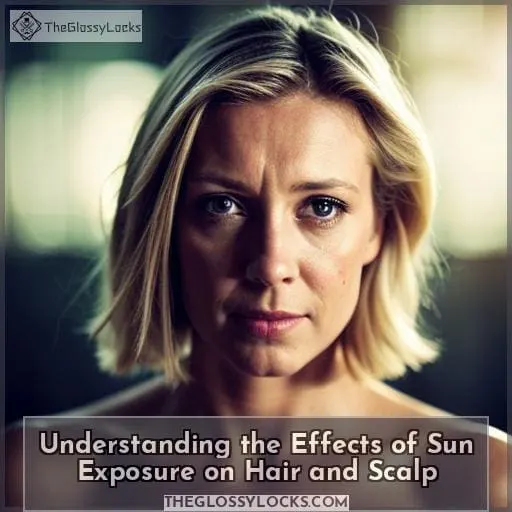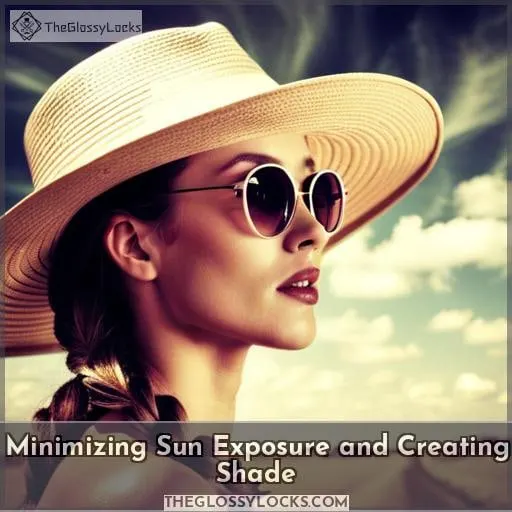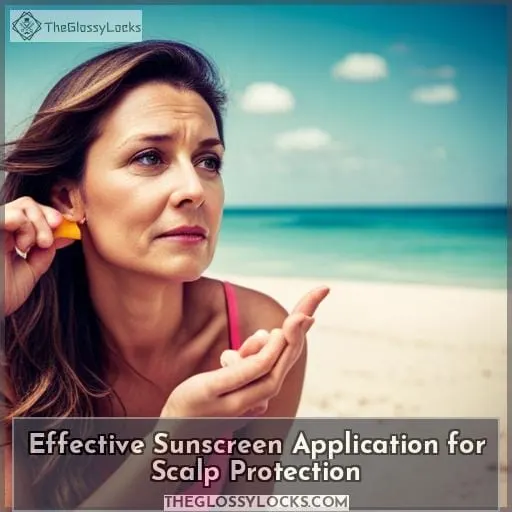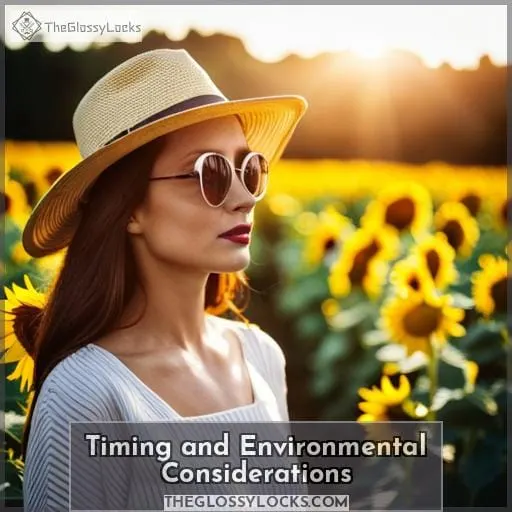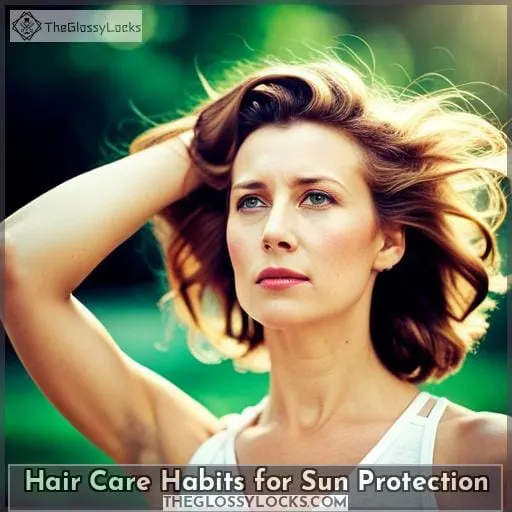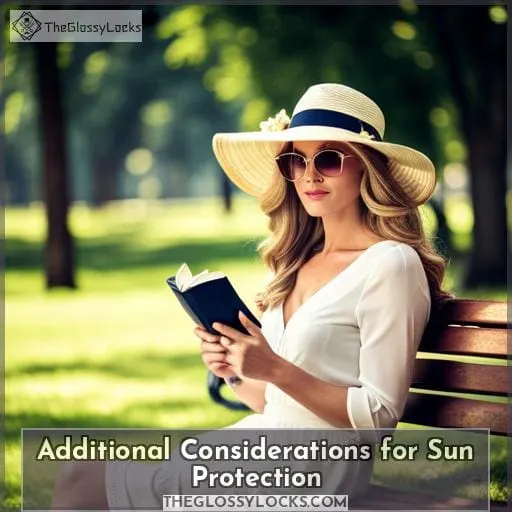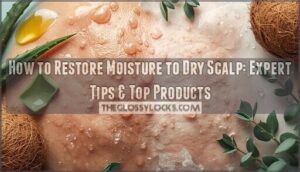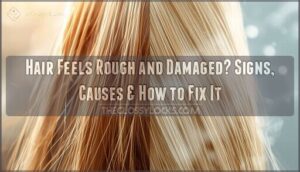This site is supported by our readers. We may earn a commission, at no cost to you, if you purchase through links.
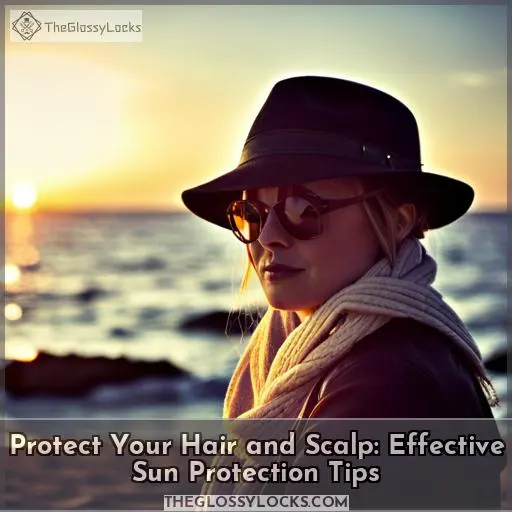
That’s right – prolonged sun exposure can damage your hair and even cause scalp burns. But don’t worry! In this article, we’ll share effective tips on how to protect your hair and scalp from the sun.
Table Of Contents
- Key Takeaways
- Understanding the Effects of Sun Exposure on Hair and Scalp
- Minimizing Sun Exposure and Creating Shade
- Effective Sunscreen Application for Scalp Protection
- Timing and Environmental Considerations
- Hair Care Habits for Sun Protection
- Additional Considerations for Sun Protection
- Frequently Asked Questions (FAQs)
- Can wearing a hat alone provide enough protection for the scalp from sun damage?
- How can I protect my hair and scalp while swimming in the ocean or pool?
- Are there any specific hair care products that can help protect against sun damage?
- Can certain hairstyles offer better sun protection for the scalp?
- Is there a difference in sun damage susceptibility between different hair types?
- Conclusion
Key Takeaways
- Minimize sun exposure and seek shaded areas.
- Wear a hat or head covering for added protection.
- Use sunscreen specifically formulated for the scalp.
- Take care of your hair by using sulfate-free shampoo, limiting heat treatments, and rinsing thoroughly after swimming.
Understanding the Effects of Sun Exposure on Hair and Scalp
When you expose your hair and scalp to the sun, UV rays can cause damage.
UVB radiation weakens the integrity of your hair strands, while UVA radiation can lead to changes in hair color.
These effects result in weakened and brittle strands, emphasizing the importance of protecting both types of UV rays for healthy-looking hair.
UV Rays and Hair Damage
Protecting your hair and scalp from UV rays is crucial as prolonged sun exposure weakens strands, causing brittleness and breakage.
Ensure UV damage prevention with:
- Stylish hat choices
- Sunscreen selection
- Proper hair hydration
UVB Radiation and Hair Integrity
To maintain the health and integrity of your hair, understand how UVB radiation weakens strands and leads to damage.
UVA Radiation and Hair Color Changes
As you learn about sun exposure’s effects on your hair and scalp, understand how UVA radiation can change hair color.
Weakened Strands and Brittle Hair
Exposure to UV rays weakens strands and leads to brittle hair, making it essential to take proactive measures for protection.
- Protect your hair resilience with protective styling options like braids or buns.
- Don’t fall for sunscreen myths on the scalp; use alternatives like hats or umbrellas.
- Maintain hair hydration through deep conditioning and incorporating hydrating habits into your routine.
Importance of Protection From Both Types of UV Rays
When spending time outdoors, it’s essential to protect your hair and scalp from both types of UV rays.
| Importance of Protection From Both Types of UV Rays |
|---|
| – UV Impact on Hair |
| – Sunscreen Effectiveness |
| – Stylish Sun Protection |
| – Hair Hydration |
| – Shade Strategies |
Minimizing Sun Exposure and Creating Shade
To protect your hair and scalp from the damaging effects of the sun, it’s important to minimize sun exposure and create shade.
- Avoid peak sunlight hours between 10 AM to 2 PM when UV radiation is strongest.
- Wear a hat or head covering for added protection and seek shaded areas when outdoors.
- Additionally, make sure to apply sunscreen specifically formulated for exposed scalp areas, focusing on thinning hair or braids, using reef-safe mineral-based options for optimal defense against harmful UV rays.
Avoiding Peak Sunlight Hours
To minimize the harmful effects of sun exposure on your hair and scalp,
avoid being outdoors during peak sunlight hours.
Wearing Sun-Protective Hats or Head Coverings
To minimize your exposure to harmful UV rays, protect your hair and scalp by wearing sun-protective hats or head coverings.
- Hat styles for all fashion choices
- Sunscreen innovations like sunscreen sticks for easy application
- Celebrity favorites & DIY options with scalp sprays for added protection
Seeking Shaded Areas or Creating Shade
To minimize sun exposure and protect your hair and scalp,
- Seek shaded areas
- Create shade with stylish hats.
Applying Sunscreen to Exposed Scalp Areas
When seeking shaded areas or creating shade to protect your hair and scalp from the sun’s harmful rays, remember to apply scalp sunscreen.
- Use a lightweight sunscreen specifically formulated for the scalp.
- Focus on applying it along the part line and thinning areas.
- Ensure complete coverage by gently massaging it into your exposed scalp.
Using Reef-Safe Mineral-Based Sunscreen
Apply reef-safe mineral-based sunscreen to protect your scalp from harmful UV rays.
While minimizing sun exposure and creating shade.
Effective Sunscreen Application for Scalp Protection
To effectively protect your scalp from the sun’s harmful rays, there are a few key strategies to keep in mind.
Firstly, it’s important to apply sunscreen even on cloudy days as UV light can still penetrate through clouds.
Additionally, choosing wide-brimmed hats provides an extra layer of protection for your scalp and face.
When selecting sunscreen for your scalp, opt for lightweight and non-oily formulas that will be easily absorbed.
Lastly, don’t forget to reapply sunscreen every two hours especially during extended outdoor activities to ensure continuous protection throughout the day.
Applying Sunscreen on Cloudy Days
Don’t forget to apply sunscreen on cloudy days to protect your scalp from harmful UV rays.
Clouds don’t block all UV radiation.
Choosing Wide-Brimmed Hats for Additional Protection
To provide additional protection for your scalp, choose wide-brimmed hats that shield against harmful UV rays.
These stylish accessories complement fashion trends while providing sun protection.
Opting for Higher SPF (at Least SPF 30) for Extended Outdoor Activities
When you’re planning to spend extended time outdoors, opt for a sunscreen with at least SPF 30 for effective protection of your hair and scalp.
Using Lightweight, Non-Oily Sunscreens for Better Scalp Absorption
For effective scalp protection, choose lightweight, non-oily sunscreens with a minimum SPF of 30 for better absorption and efficacy.
Reapplying Sunscreen Every Two Hours
Make sure to reapply sunscreen every two hours for effective scalp protection. This is especially important considering hat styles, skin sensitivity, and hair hydration.
Timing and Environmental Considerations
To effectively protect your hair and scalp from the sun, it’s important to consider timing and environmental factors.
- Avoiding peak sun intensity by staying indoors or seeking shade during midday hours can significantly reduce exposure.
- Additionally, exercise caution near water, snow, and sand as they reflect UV light.
- Consider protective hairstyles like ponytails or updos to minimize direct sunlight on the scalp.
- Checking the UV index regularly will help gauge your risk of sun exposure and allow you to take appropriate precautions.
- Finally, maintaining clean hair helps prevent sun damage so avoid excessive washing when possible.
Avoiding Peak Sun Intensity
To effectively protect your hair and scalp from the sun’s harmful rays, be mindful of peak sun intensity by:
- Staying indoors
- Seeking shade whenever possible
Exercising Caution Near Water, Snow, and Sand
When near water, snow, and sand, protect your hair and scalp from harmful UV rays.
Water reflects UV rays, so be cautious.
Considering Protective Hairstyles
As you exercise caution near water, snow, and sand, consider protective hairstyles for added sun protection.
Here are some options:
- Braids
- Buns
- Ponytails
- Updos
Checking the UV Index for Sun Exposure Risk
Check the UV index to gauge your risk of sun exposure.
The UV index scale and chart provide valuable information on sun intensity levels for today.
Maintaining Clean Hair for Sun Damage Prevention
To maintain clean hair and prevent sun damage, consider timing and environmental factors.
- Limit shampooing to preserve hair strength.
- Avoid heat treatments and hair dyeing for reduced damage.
- Prioritize sun protection for healthy hair.
Hair Care Habits for Sun Protection
To protect your hair and scalp from the damaging effects of the sun, there are several important habits to incorporate into your routine.
Start by using sulfate-free shampoo with natural ingredients to keep your hair healthy and strong.
When washing your hair, opt for warm water instead of hot water to avoid drying out your scalp.
Additionally, limit the use of styling gels and lotions that can attract more sunlight to your strands.
Finally, minimize heat treatments like curling irons or blow dryers that can further weaken and damage sun-exposed hair.
And don’t forget to rinse thoroughly after swimming in chlorinated pools!
Using Sulfate-Free Shampoo With Natural Ingredients
When protecting your hair and scalp from the sun’s harmful rays, consider using sulfate-free shampoo with natural ingredients for gentle cleansing and scalp protection.
Washing Hair With Warm, Not Hot, Water
When washing your hair for sun protection, opt for warm water instead of hot water.
Hot water can cause more damage to your hair, while warm water causes less damage.
Limiting Use of Styling Gels and Lotions
If you want to effectively protect your hair and scalp from the sun, limit your use of styling gels and lotions.
Minimizing Heat Treatments (Curling Irons, Blow Dryers)
To further protect your hair and scalp from sun damage, minimize the use of heat treatments like curling irons and blow dryers.
- Use a heat protectant spray or serum to reduce hair damage.
- Avoid applying excessive heat directly to the scalp to prevent potential burns.
- Heat can cause color fading, so use a heat protectant specifically designed for preserving hair color.
- Minimizing heat treatments helps maintain overall hair health by reducing breakage and brittleness.
- Prioritize using products that offer both sun protection and nourishment for optimal care.
Rinsing Hair After Swimming in Chlorinated Pools
After swimming in chlorinated pools, rinse your hair thoroughly to remove chlorine residue and protect it from sun damage.
| Benefits of Rinsing Hair After Swimming | Tips for Effective Hair Rinsing |
|---|---|
| Removes Chlorine Residue | Use lukewarm water |
| Prevents Scalp Irritation | Massage scalp gently |
| Preserves Hair’s Sun Protection | Use a sulfate-free shampoo |
Rinsing your hair after swimming in chlorinated pools is essential for maintaining healthy hair and protecting it from sun damage. Chlorine can strip the natural oils from your hair, leaving it dry and brittle. Additionally, prolonged exposure to the sun can further weaken your strands and cause color changes.
By rinsing out the chlorine residue after swimming, you not only prevent scalp irritation but also preserve the effectiveness of any sunscreen or protective products applied earlier.
To ensure effective rinsing of your hair, follow these tips:
- Use lukewarm water: Hot water can strip away moisture from both your scalp and strands.
- Massage scalp gently: This helps loosen any remaining chlorine particles trapped on the surface.
- Use a sulfate-free shampoo: Sulfates can be harsh on already exposed hair; opt for gentle cleansing alternatives instead.
By incorporating regular post-swim rinses into your routine, you’ll keep both your hair and scalp healthy and protected.
Additional Considerations for Sun Protection
When it comes to protecting your hair and scalp from the sun, there are some additional considerations to keep in mind.
First, try to avoid frequent hair dyeing or bleaching as these processes can make your hair more susceptible to UV damage.
Additionally, be cautious with using shampoo that contains coal tar, as this ingredient can increase sensitivity to the sun.
Finally, if you use tanning beds or sunlamps for a bronzed look, remember that they also expose your hair and scalp to harmful UV rays.
Avoiding Frequent Hair Dyeing or Bleaching
How can you protect your hair and scalp from sun damage while avoiding frequent hair dyeing or bleaching?
Hair dyes and bleaches contribute to sun damage, hair loss, and even scalp cancer.
Checking Shampoo Ingredients for Coal Tar Sensitivity
When checking shampoo ingredients for coal tar sensitivity, be mindful of potential risks to your hair and scalp.
- Coal tar in shampoos can increase sun sensitivity.
- Avoid using coal tar-containing shampoos if you frequently dye or bleach your hair.
- Tanning beds and sunlamps also expose the scalp to harmful UV rays, so extra caution is needed.
- Opt for sunscreen specifically formulated for the scalp to protect against sun exposure while using these products.
Coal tar is a common ingredient found in certain shampoos that may cause sensitivity to sunlight, leading to an increased risk of burning or other forms of damage when exposed to the sun’s rays.
Hair dyeing can already make your strands more vulnerable due to chemical processes involved; combining it with coal tar-containing products further heightens this susceptibility.
Tanning beds and sunlamps emit ultraviolet (UV) radiation similar to that from natural sunlight, making them potentially harmful as well if you have sensitivities related either directly or indirectly through product use containing substances like coal tars which amplify such effects on skin/scalp conditions sensitive towards their components’ action on melanocytes (pigment-producing cells).
Using sunscreen specifically formulated for the scalp can provide additional protection against both UVA and UVB rays when using these types of products associated with higher rates/susceptibility towards photo-sensitivity-related issues arising out-of-doors during periods where direct contact occurs between atmospheric light sources reaching one’s head area/region(s), especially those having undergone treatments involving application(s) containing compounds known constituents capable influencing biological responses affecting said tissues/organs/systems thereof responsible regulating homeostatic balance within individuals affected by such factors predisposing them being at elevated risk developing adverse reactions/melanoma/carcinogenesis etc.
Attributable primarily but not limited exclusively around usage patterns involving prolonged/chronic exposures over extended durations corresponding cumulative exposure effects occurring over time plus any inherent genetic predispositions towards particular conditions (e.
Being Cautious With Tanning Beds and Sunlamps
When using tanning beds and sunlamps, exercise caution to protect your hair and scalp from the increased risk of skin cancer.
Additional Considerations for Sun Protection:
- Avoid excessive use of tanning beds or sunlamps due to increased sun exposure.
- Hair dyeing or bleaching can increase sensitivity to UV rays, requiring extra precautions.
- Protect your scalp by applying reef-safe mineral sunscreen specifically formulated for the hair.
Choosing Reef-Safe Mineral Sunscreens for Scalp
To ensure optimal sun protection for your scalp, choose reef-safe mineral sunscreens that are specifically formulated to safeguard both your hair and skin.
- Look for sunscreen with zinc oxide or titanium dioxide (non-nano) as active ingredients.
- Ensure it’s labeled as reef-safe and broad-spectrum for comprehensive protection.
- Opt for water-resistant and sweat-proof formulas to maintain effectiveness during outdoor activities.
Taking Precautions During Peak Sun Hours, Especially With Medication Sensitivity
During peak sun hours, especially with medication sensitivity, it’s crucial to protect your hair and scalp by using sunscreen and taking extra precautions.
Frequently Asked Questions (FAQs)
Can wearing a hat alone provide enough protection for the scalp from sun damage?
Wearing a hat alone is beneficial, but it may not provide sufficient protection for the scalp from sun damage.
To ensure optimal defense, combine hat usage with other measures like sunscreen application and seeking shade whenever possible.
How can I protect my hair and scalp while swimming in the ocean or pool?
To protect your hair and scalp while swimming, consider wearing a swim cap or applying a waterproof sunscreen designed for the hair. These measures will help shield your strands from sun damage caused by UV rays in the water.
Are there any specific hair care products that can help protect against sun damage?
To protect your hair and scalp from sun damage, consider using hair care products that offer UV protection.
Look for products with SPF or those specifically formulated to shield against harmful UV rays.
Can certain hairstyles offer better sun protection for the scalp?
Certain hairstyles can offer better sun protection for the scalp.
Opting for protective styles like ponytails, buns, or updos helps shield your scalp from harmful UV rays.
It’s a simple yet effective way to safeguard your hair and promote overall scalp health.
Is there a difference in sun damage susceptibility between different hair types?
Different hair types have varying susceptibility to sun damage.
Those with lighter and finer hair are generally more prone, while darker and thicker hair provides some natural protection.
However, it’s important for everyone to take proactive measures to safeguard their scalp from harmful UV rays.
Conclusion
To protect your hair and scalp from the damaging effects of the sun, it’s important to take proactive measures.
- Avoid peak sunlight hours.
- Seek shade.
- Wear sun-protective hats or head coverings.
- Apply sunscreen to exposed scalp areas, opting for mineral-based and reef-safe options.
Consider timing and environmental factors, such as:
- Avoiding peak sun intensity.
- Protecting your hair near water, snow, and sand.
Adapt your hair care habits, using:
- Sulfate-free shampoo.
- Limiting heat treatments.
By following these tips, you can keep your hair and scalp safe and healthy under the sun.

